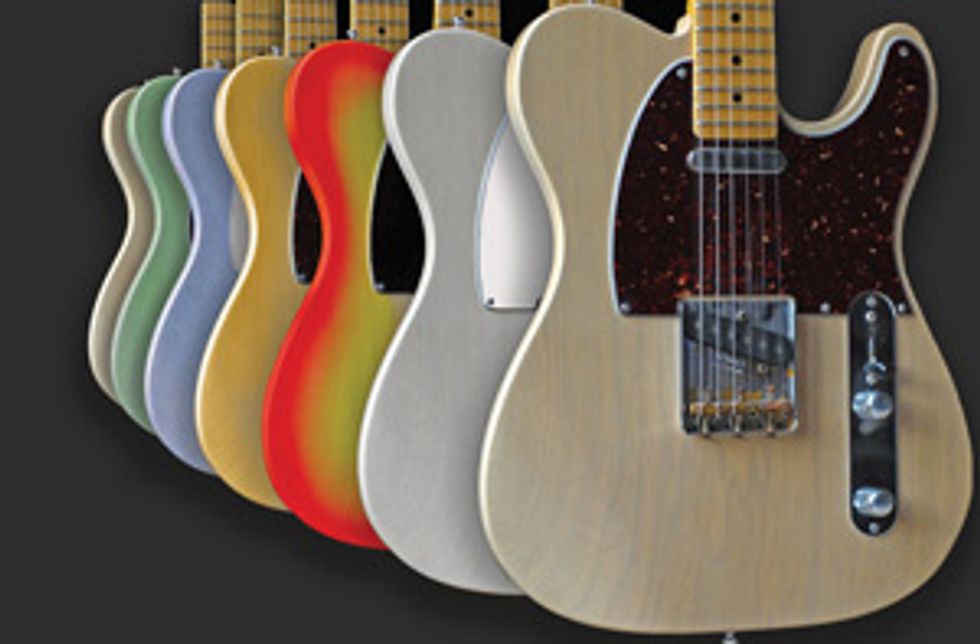
The Fender Telecaster is one example of an instrument design that has certainly withstood the test of time.
A while ago, I watched a polemical film about the birth of accelerated consumerism and the invention of planned obsolescence. In The Light Bulb Conspiracy, filmmaker Cosima Dannoritzer chronicles the creation and implementation of reduced product-life spans to fuel commerce. It’s an interesting and compelling—albeit a bit heavy-handed—theorem on how we got to where we are today, and the crash that will inevitably come. Likewise, the oft-quoted warning by retail analyst Victor Lebow in his paper “Price Competition in 1955” gets to the meat of the matter, describing the mechanisms of advertising as a social experiment. He outlines fashion as the final and necessary component of the consumption machine. The American consumer, Lebow writes, “convert[s] the buying and use of goods into rituals … he tends to express his aspirations and his individuality in terms of what he wears, drives, eats—his home, his car, his pattern of food serving, his hobbies.” Lebow’s thesis sounds like my own experiment in self-delusion that I call a guitar collection. But wait a minute. My half-century-old instruments still function perfectly fine. What happened?
One of the things I love about the musical-instrument business is how the market itself constantly outwits and torments manufacturers. Unlike the giant automotive and computer industries—guitar, amp, and effects trends seem resistant to most attempts to change or move forward. A rock musician from the 1960s awakening from a 45-year sleep would instantly recognize many of the products in any music store today. Can you imagine General Motors turning out the 1957 Chevrolet Bel Air in 2013? Whatever small changes do occur usually start at the grassroots level and percolate on stages and studios long before they are reflected in any sort of action from larger companies. Their marketing folks read these very pages to get a whiff of what’s happening. But how many new ideas are solutions to questions that nobody is asking?
I just recently tested several new self-tuning bridge designs—all of which are aimed at eliminating the constant twiddling with pitch that stands like a tollgate troll at the entrance to a secret society inhabited by (gasp) skilled musicians. Power to the people! If only some device could pitch-correct vocals.
When I wrote about the upstart breeding ground for new ideas known as NAMM’s Hall E in a previous column [“Brainstorms from NAMM’s Budget Basement,” February 2011], I pointed out that from time to time, real innovations are thrust upon us with varying degrees of success. Take the Floyd Rose locking system for example, which flew below the radar for several years before going mainstream. I recall meeting Floyd and first checking out his invention as he sat with it in the corner of an all-but-ignored, shared trade-show booth. It wasn’t until a number of small builders began offering his device as an option that it made enough noise to eventually get the attention of the bigger companies. Now we just take its existence for granted. The key to the Floyd’s taking off is that it actually solved a problem.
Another area under constant attack by designers is pickup switching. Once upon a time, the Fender Stratocaster came equipped with a lowly 3-way switch. But musicians found that by balancing the lever between positions, they could take advantage of an additional two sounds that employed multiple pickups. In turn, the manufacturer eventually provided a legit 5-way to make the balancing act a bit more precise. And once the aftermarket made tappable and splittable pickups available in the 1970s, guitars bristled with mini switches or push-pull potentiometers to control a new wealth of sonic options. Many of these tones may have been immortalized on recordings that have slipped our minds and faded into oblivion. It’s no wonder that with the powerful digital-switching circuits available now, guitar companies have returned to the idea of providing more tonal flexibility. Who wouldn’t want 15,000 incremental stages of high-frequency roll off? The perfect combination of midrange snarl and low-end cancellation created by elaborate combinations of split and reverse-phase pickups might just be the hook that pushes your song over the cliff into iconic status. Maybe not exactly like the wah wah on “White Room,” but you get the picture, right?
Of course, when all else fails, a new paint job can relaunch the life cycle of any product. I recall working with a vacuum-plating process to develop a mirror-finish-chrome look for a customer in the 1980s, and it wasn’t long before I saw some examples on display at the NAMM convention in Anaheim. (I think it’s still sort of a trademark look for Joe Satriani.) The idea of the guitar as a fashion statement or as a color-keyed component of a stage set is not new, but few of us can resist the allure of a new hue in our wardrobe, er, I mean arsenal. Can you just imagine an iPhone in red? Again, it works well for the first to the party, but staying power is another thing altogether.
Will we obediently comply with the siren song of newer, better, and faster? Will any of this year’s new products precipitate the demise of my old-school gear’s relevance? I seriously doubt it, but the idea of never tuning my guitar again is tempting.
 Jol Dantzig is a
noted designer, builder,
and player who co-founded
Hamer Guitars,
one of the first boutique
guitar brands, in 1973.
Today, as the director of
Dantzig Guitar Design, he continues to
help define the art of custom guitar. To
learn more, visit guitardesigner.com.
Jol Dantzig is a
noted designer, builder,
and player who co-founded
Hamer Guitars,
one of the first boutique
guitar brands, in 1973.
Today, as the director of
Dantzig Guitar Design, he continues to
help define the art of custom guitar. To
learn more, visit guitardesigner.com.


























